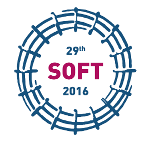Speaker
Ngoc Minh Trang Vu
(IRFM)
Description
The control of the safety factor q and/or the electronic temperature Te profiles is a key issue to achieve advanced plasma scenarios with high repeatability. This paper will discuss the new results of such plasma internal profile control on TCV, using total plasma current Ip, and ECCD heating source. The issue is that only the ECCD heating power is controlled, since the distributed heating profile has a pre-defined (Gaussian) shape. The control model is governed by the resistive diffusion equation coupled with a thermal transport equation. It is written in PCH (Port-Controlled Hamiltonian) formulation, where the system interconnection structure, dissipation and energy density are all explicit. Based on this model and from some reference values at some positions of q and Te profiles, the controller generates the admissible plasma profiles accompanying with a non-linear feedforward control.
The feedback control based on a linear IDA-PBC (Interconnection and Damping Assignment - Passivity based Control) handles the convergence speed and the robustness by modifying the dissipation properties of the closed-loop system.
The developed controller has been implemented into RAPTOR code for simulation tests before its integration in the TCV real-time control system. Two test scenarios are considered. The first one is based only on q-profile control, the total ECCD heating power is kept constant and only the difference between the ECCD sources which generates co-current and counter-current is controlled. While the second one extends to total plasma thermal energy control with the total ECCD power playing the role of control signal.
Different profiles of ECCD for co-current and counter-current are taken into account and a PCH integrator is also added to successfully track the references in several test scenarios. The obtained results let us trust of a routine use of such plasma advanced control algorithm in the future for physic studies.
Co-authors
Bert Maljaars
(Faculty of Mechanical Engineering, Control Systems Technology Group, Eindhoven University of Technology, P.O. Box 513, 5600 MB Eindhoven, Netherlands)
Federico Felici
(Faculty of Mechanical Engineering, Control Systems Technology Group, Eindhoven University of Technology, P.O. Box 513, 5600 MB Eindhoven, Netherlands)
Ngoc Minh Trang Vu
(IRFM, CEA Cadarache, F-13108 Saint-Paul-lez-Durance, France)
Olivier Sauter
(CRPP, EPFL, Lausanne, Switzerland)
Remy Nouailletas
(IRFM, CEA Cadarache, F-13108 Saint-Paul-lez-Durance, France)

